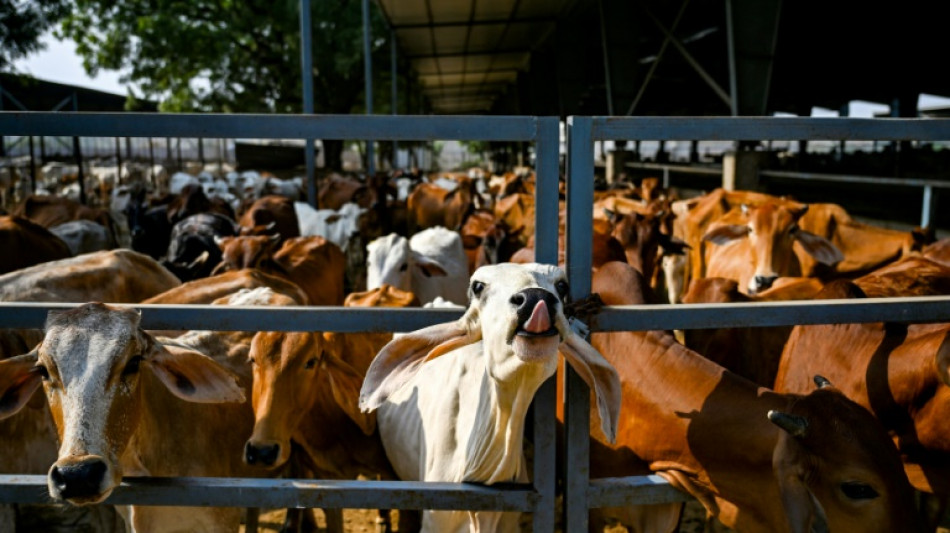
-
 Tunisia women herb harvesters struggle with drought and heat
Tunisia women herb harvesters struggle with drought and heat
-
Trump threatens to take back control of Panama Canal

-
 India's architecture fans guard Mumbai's Art Deco past
India's architecture fans guard Mumbai's Art Deco past
-
Secretive game developer codes hit 'Balatro' in Canadian prairie province

-
 Large earthquake hits battered Vanuatu
Large earthquake hits battered Vanuatu
-
Beaten Fury says Usyk got 'Christmas gift' from judges

-
 First Singaporean golfer at Masters hopes 'not be in awe' of heroes
First Singaporean golfer at Masters hopes 'not be in awe' of heroes
-
Usyk beats Fury in heavyweight championship rematch

-
 Stellantis backtracks on plan to lay off 1,100 at US Jeep plant
Stellantis backtracks on plan to lay off 1,100 at US Jeep plant
-
Atletico snatch late win at Barca to top La Liga

-
 Australian teen Konstas ready for Indian pace challenge
Australian teen Konstas ready for Indian pace challenge
-
Strong quake strikes off battered Vanuatu

-
 Tiger Woods and son Charlie share halfway lead in family event
Tiger Woods and son Charlie share halfway lead in family event
-
Bath stay out in front in Premiership as Bristol secure record win

-
 Mahomes shines as NFL-best Chiefs beat Texans to reach 14-1
Mahomes shines as NFL-best Chiefs beat Texans to reach 14-1
-
Suspect in deadly Christmas market attack railed against Islam, Germany

-
 MLB legend Henderson, career stolen base leader, dead at 65
MLB legend Henderson, career stolen base leader, dead at 65
-
Albania announces shutdown of TikTok for at least a year

-
 Laboured Napoli take top spot in Serie A
Laboured Napoli take top spot in Serie A
-
Schick hits four as Leverkusen close gap to Bayern on sombre weekend

-
 Calls for more safety measures after Croatia school stabbings
Calls for more safety measures after Croatia school stabbings
-
Jesus double lifts Christmas spirits for five-star Arsenal

-
 Frankfurt miss chance to close on Bayern as attack victims remembered
Frankfurt miss chance to close on Bayern as attack victims remembered
-
NBA fines Celtics coach Mazzulla and Nets center Claxton

-
 Banned Russian skater Valieva stars at Moscow ice gala
Banned Russian skater Valieva stars at Moscow ice gala
-
Leading try scorer Maqala takes Bayonne past Vannes in Top 14

-
 Struggling Southampton appoint Juric as new manager
Struggling Southampton appoint Juric as new manager
-
Villa heap pain on slumping Man City as Forest soar

-
 Suspect in deadly Christmas market attack railed against Islam and Germany
Suspect in deadly Christmas market attack railed against Islam and Germany
-
At least 32 die in bus accident in southeastern Brazil

-
 Freed activist Paul Watson vows to 'end whaling worldwide'
Freed activist Paul Watson vows to 'end whaling worldwide'
-
Chinese ship linked to severed Baltic Sea cables sets sail

-
 Sorrow and fury in German town after Christmas market attack
Sorrow and fury in German town after Christmas market attack
-
Guardiola vows Man City will regain confidence 'sooner or later' after another defeat

-
 Ukraine drone hits Russian high-rise 1,000km from frontline
Ukraine drone hits Russian high-rise 1,000km from frontline
-
Villa beat Man City to deepen Guardiola's pain

-
 'Perfect start' for ski great Vonn on World Cup return
'Perfect start' for ski great Vonn on World Cup return
-
Germany mourns five killed, hundreds wounded in Christmas market attack

-
 Odermatt soars to Val Gardena downhill win
Odermatt soars to Val Gardena downhill win
-
Mbappe's adaptation period over: Real Madrid's Ancelotti

-
 France's most powerful nuclear reactor finally comes on stream
France's most powerful nuclear reactor finally comes on stream
-
Ski great Vonn finishes 14th on World Cup return

-
 Scholz visits site of deadly Christmas market attack
Scholz visits site of deadly Christmas market attack
-
Heavyweight foes Usyk, Fury set for titanic rematch

-
 Drone attack hits Russian city 1,000km from Ukraine frontier
Drone attack hits Russian city 1,000km from Ukraine frontier
-
Former England winger Eastham dies aged 88

-
 Pakistan Taliban claim raid killing 16 soldiers
Pakistan Taliban claim raid killing 16 soldiers
-
Pakistan military courts convict 25 of pro-Khan unrest

-
 US Congress passes bill to avert shutdown
US Congress passes bill to avert shutdown
-
Sierra Leone student tackles toxic air pollution


Sacred cow: coal-hungry India eyes bioenergy to cut carbon
Venerated as incarnations of Hindu deities, India's sacred cows are also being touted as agents of energy transition by a government determined to promote biogas production to cut its dependence on coal.
It is an understatement to say that Nakul Kumar Sardana is proud of his new plant at Barsana, in India's northern Uttar Pradesh state.
Firstly, says the vice-president of a biomass joint venture between India's Adani Group and France's TotalEnergies, because it occupies "one of the holiest sites in the world".
A four-hour drive south of the smog-filled capital New Delhi, among fields bristling with brickyard smokestacks, the small town of Barsana welcomes pilgrims who come to honour the Hindu goddess Radha.
But Sardana is also proud because his methanisation plant that opened in March is the "most technologically advanced and the largest biogas facility" in India.
It was built in Barsana to be as close as possible to its raw fuel -- cattle dung and harvest stubble.
"This region is home to a million cows," he said. "Their dung has been used as fuel for centuries in cooking".
Cows have been blamed for contributing to global warming because they produce methane -- a powerful greenhouse gas -- in their manure or when they belch.
But in this case, the region is finding a creative use for the waste produced by the cattle, which are used for their milk. Eating them is taboo for many Hindus.
Stalks left behind after the rice harvest -- that would otherwise be burned -- join the slurry.
"Farmers are traditionally burning them, creating smog and pollution", he added.
"In using natural waste, we are not only producing compressed biogas, but also high-quality organic fertiliser."
Long lines of tractors dump dung and straw in the factory's tanks, from which 10 tonnes of gas and 92 tonnes of fertiliser are produced each day.
- 'Convert waste' -
In its endless quest for power to fuel its economic growth, the world's most populous nation -- and third-largest fossil fuel polluter -- has pushed biogas to achieve a much-promised transition to carbon neutrality by 2070.
In 2018, the government set itself an ambitious goal of building 5,000 biogas plants in six years.
But despite generous subsidies and the introduction of a buyback guarantee, the project attracted little initial interest -- until the government forced the hand of producers.
From April 2025, at least one percent of liquid gas fuelling both vehicles and for domestic use must be biogas -- rising to five percent by 2028.
That prompted a response from key players, starting with billionaires Mukesh Ambani and Gautam Adani -- both close to Prime Minister Narendra Modi -- eying lucrative public contracts.
Ambani promised his Reliance group would build 55 biogas plants by the end of 2025 to convert "food producers to energy producers" and generate 30,000 jobs.
His rival Adani plans to invest around $200 million in the sector in the next three to five years.
"The government is pushing to convert waste for the wealth of the country," said Suresh Manglani, CEO of Adani Total Gas.
The International Energy Agency (IEA) says both China and India are leading global growth in bioenergy, seen as one solution to mitigate global heating.
Even though biofuel remains more expensive than conventional gas, Indian production is expected to grow by 88 percent by 2030, it predicts.
Biogas is considered a clean energy because the waste used to produce it is completely natural, said Suneel Pandey of The Energy and Resources Institute.
It is "a sustainable solution to make wealth from waste," he told AFP.
- 'Potential is huge' -
But the contribution of biogas to India's transition away from heavily polluting coal -- currently fuelling nearly 70 percent of electricity --- will be relatively small.
India plans to more than double the share of gas in its energy mix -- from six to 15 percent by 2030.
But the bulk of that will be liquefied natural gas (LNG), with Adani and TotalEnergies opening an LNG port on India's eastern coast at Dhamra.
Burning gas to produce electricity also releases damaging emissions, although less than coal and oil.
Total argues its backing of biogas is more about environmental responsibility than commercial opportunity.
"Biogas goes way beyond figures and business plans," said Sangkaran Ratnam, TotalEnergies chairman and managing director for India.
"It has also a tremendously positive knock-on effect on the rural communities in terms of jobs, in terms of care for the environment, and alternative forms of income."
Tejpreet Chopra, head of renewable energy company Bharat Light and Power, said the biogas market is "small in the big picture of things" but the "potential is huge".
But the investments required are vast. The Barsana plant cost $25 million, while the price of biogas remains uncompetitive: $14 per cubic metre, compared to $6 for LNG.
Yet Sardana remains more convinced than ever that biogas is key.
"We will learn the nuts and bolts of it and improve all processes," he said.
"We stop wasting energy, we create rural jobs, and we are contributing to a more sustainable environment."
A.S.Diogo--PC




